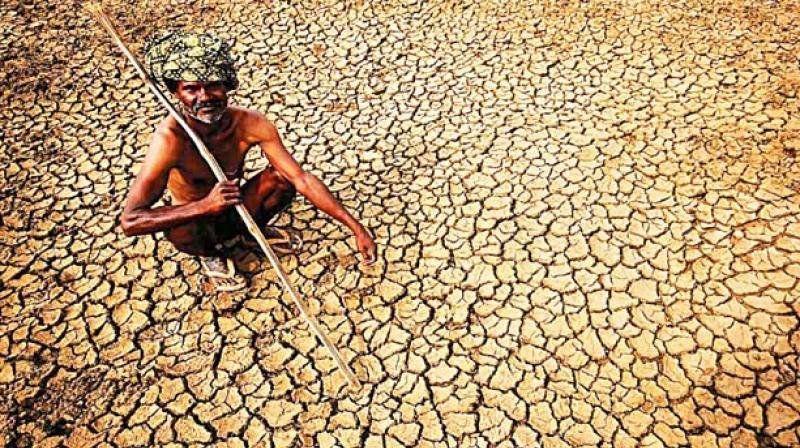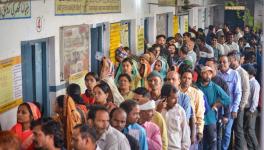Drought in Karnataka: A Human-made Disaster

The Karnataka government will soon announce 28 more talukas as ‘drought-hit’, adding to the existing 86, reported The New Indian Express. The inter-ministerial central team (IMCT) that visited Karnataka to assess the drought situation, reported that 72 out of 100 talukas are severely affected by drought during the kharif season, while there was moderate impact in rest of the talukas.
IMCT has been deputed by the central government to assess the drought situation in six states – Andhra Pradesh, Maharashtra, Rajasthan, Gujarat, Jharkhand and Odisha. However According to the data compiled by the Karnataka State Natural Disaster Monitoring Centre, till December 9, 86 of the 176 talukas received deficient rainfall during the Southwest monsoon, or kharif season, while 162 talukas received deficient rain in the Northeast cycle, or rabi season, reported Livemint. Of the 30 districts across the state, 24 are drought-hit, and it is estimated that the drought has resulted in a loss of Rs 16, 662 crore.
The drought is generally brushed away, accusing farmers to be overly dependent on the monsoon rains (of course such arguments fail to explain the government’s disinterest in making the alternatives available), or is viewed to be just a natural disaster. Thus, it is concluded that no government can prevent it. Surely, the rains are not under the control of the governments, but the actual question is, are the governments in the country interested in making the situation better for the farmers? Taking a close look at the agricultural policies of the governments in the context of the growing agrarian crisis in the country, it can be concluded that these policies are not in the interest of the farmers.
Also Read: After Drought, Karnataka Farmers Hit With Crash in Prices of Agricultural Produce
For example, as early as in the beginning of the August of 2018, R V Deshpande, the Revenue Minister of the state of Karnataka, had acknowledged the insufficient rainfall in the 13 districts in the Northern region of the state, and the consequential drought. Overall, Karnataka had recorded heavy rainfall this monsoon, and the Western parts of the state were flooded. However, the Northern districts of the state were untouched by the monsoon this year as well, making this the 14th year of drought in the region. The revenue minister had also noted that due to the changes in the benchmark defining drought situation by the central government, it is not possible to declare the region as drought-hit. Not being able to declare these regions drought-hit, with hands tied by the central government’s new definition of the drought, now the state government is facing an agrarian crisis that was avoidable.
The state, so far, has released Rs 43 crore for providing drinking water, and Rs 15 crore to the Animal Husbandry Department to provide fodder to the cattle in the 86 drought-hit talukas.
Karnataka is also one of the states where the farmers are in extreme distress. According to a report in the Business Standard, kharif sowing in the state was good, as monsoon’s progress was not that bad during June and July. However, the dry spell during September led to damage to the crops, the official said, adding that the state has demanded a relief of Rs 24.34 billion.
Drought Manual of 2016
Drought manual of 2016 by the current Bharatiya Janata Party (BJP)-led central government, is a manual that would help the central government to wash its hands off the responsibility of attending to the agrarian crises. In this tussle between the governments, the farmers’ interest is completely overlooked.
The new manual proposes a complex matrix-based analysis to indicate the nature of the drought, i.e. ‘moderate’ or ‘severe’. This analysis, according to the manual, has to be based on what is called a Ground Truthing (GT) or verification. The GT is to be conducted using a smart phone-based application. “The app shall record the GPS coordinates of the site and the photo of the state of crop, with the provision to upload these parameters on a computer server for archiving for post-facto analysis,” reads the manual. In this computerised analysis, the manual noted, “An estimation of crop damage/loss of 33% or more on the basis of field verification will qualify for the declaration of drought. However, for the drought to qualify as one of a ‘severe’ nature, the estimation of damage/loss to crops should be more than 50%.”
Also Read: The Manual for Drought Management, 2016 Won’t Let North Karnataka Be Declared Drought-hit
Speaking to Village Square, Mohan Gojamgunde, an agricultural officer from Latur, remarked, “The indices for declaring severe drought are so strict that such droughts will occur only once in 10-15 years. Thus, the Centre won’t have to release any drought relief funds.”
The manual for drought management of 2016, unlike the manual of 2009, not only has made the parameters to declare drought complex and stringent, but has also limited Centre’s scope to offer financial assistance to the states. According to the new manual, for a drought to fall under the ‘severe’ category and be eligible for central assistance, the state government has to prove severity in terms of three out of the four main impact indicators. These four impact indicators are: Crop Situation Related Indices, Remote Sensing based vegetation indices, Soil Moisture Based Indices and Hydrological indices. So far, the states had been following their own system of drought assessment and drought declaration. The new manual has made it extremely difficult for the state governments to declare droughts.
The 2016 manual, on the other hand, places complete onus on the state government to provide financial assistance to the drought-affected region. The manual, which gives mandatory guidelines and stringent indices for the state governments to declare drought, notes, “Relief operations are mounted in drought affected areas by the State Governments after the notification of drought using, inter alia, funds available under the State Disaster Response Fund (SDRF). In the event of drought of a severe nature, the State Government may seek assistance from the Central Government including financial assistance from National Disaster Response Fund (NDRF).”
However, it is not only Karnataka, the agrarian crisis in the neighbouring state of Maharashtra could also be attributed to this manual. On October 31, the Maharashtra government declared drought in 151 talukas across 26 districts. Ironically, this declaration by the government was made within a few days of Prime Minister Narendra Modi’s proclamation in Shirdi that a state government scheme called, Jalyukta Shivar (field full of water) had made 16,000 villages drought-free. According to a report in the Economic and Political Weekly, “This situation cannot be blamed on the deficient rainfall alone. It is a policy-induced/human-made disaster.” As in the case of Karnataka, it was too late as the state government was caught up in negotiating with the new definition of drought.
Also Read: Why Drought-hit Marathwada Farmers Are Demanding Fodder Camps
Get the latest reports & analysis with people's perspective on Protests, movements & deep analytical videos, discussions of the current affairs in your Telegram app. Subscribe to NewsClick's Telegram channel & get Real-Time updates on stories, as they get published on our website.
























